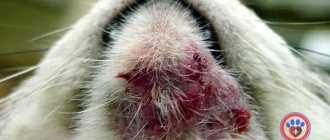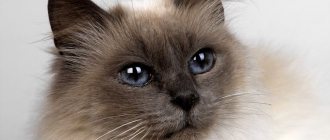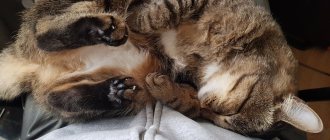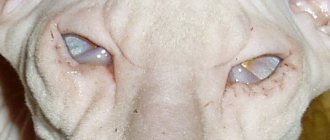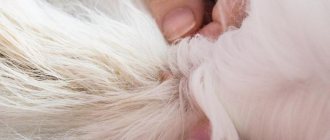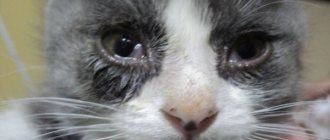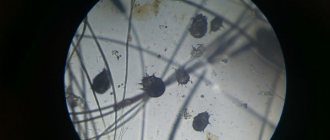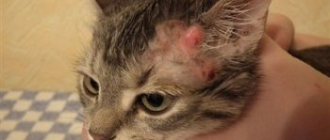What is acne
Feline acne is a skin disease that causes the formation of comedones (blackheads) on the lips and chin.
Comedones are plugs of a mixture of sebum and exfoliated epithelial cells of the hair follicles. The black color of the formation is obtained due to the pigment melanin, which colors stagnant sebaceous secretions. That’s why comedones are called “blackheads” or “dirt.” The sizes of the rashes vary - from a millet grain to a pea.
The occurrence of acne does not depend on gender, breed, or age (it can even occur in a kitten). The disease manifests itself episodically, goes through cycles, or is a constant companion of the cat. Also, acne develops regardless of whether the animal is spayed/neutered or not.
Sphynx skin care: acne and pimples
The formation of acne and pimples is typical for Sphynx cats. As a rule, they form on the tail, chin and belly of the animal. The reasons for their formation and treatment are the same as for all other cats. As a preventive measure, it is recommended to periodically wipe the areas where acne is most likely to appear - with micellar water, chlorhexidine or a special lotion (the latter should be washed off with warm water). Castration of the animal can also reduce the formation of acne, since hormonal surges contribute to the occurrence of skin problems.
Mechanism of acne development
The following mechanisms play a role in the development of acne in cats:
- Increased work of the sebaceous glands.
- Constant accumulation of exfoliated horny epithelial cells in the hair follicle.
- Bacteria.
- Inflammation.
A dense mass of desquamated cells and secretions secreted by the sebaceous glands is formed. The plug puts pressure on the tissue, causing the sebaceous gland to stop functioning and the mouth of the hair follicle to expand. A favorable environment is created for various microorganisms. The main causative agent of infectious chin acne in cats is propionibacterium acne (Latin name Cutibacterium acnes). The fungus pityrosporum and staphylococci also thrive in sebaceous plugs. At any stage of comedones, inflammation develops as a result of the penetration of pathogens.
Why do black spots appear in cat fur?
Acne in cats most often appears on the chin. This is due to the fact that there is practically no hair on this part of the body. It is where a large number of sebaceous glands are concentrated. They become contaminated when animals eat food, when dirt gets into them. But pollution is not always to blame for the fact that black rashes appear around the cat’s mouth. All cats are very clean, and caring owners provide the pet with good care. It just sometimes happens that black dots appear in a cat’s fur due to bad heredity.
You can treat acne, but you cannot completely get rid of the pathology. The only thing the owner can do in this case is to control the situation using hygiene products.
Black dots appear in a pet's fur for the following reasons::
- improper, disturbed nutrition;
- hormonal disbalance;
- problems in the central nervous system
- problems in the liver or gastrointestinal tract.
The appearance of black dots in a cat’s ears indicates poor quality care for the animal. Acne and pimples in this area of the body appear due to the accumulation of large amounts of sulfur. There is very little sulfur in the ears of healthy cats, and therefore it does not disrupt the functioning of the sebaceous glands. But this component accumulates over time, and if you do not keep your ears clean, the glands become clogged and acne forms. This problem is especially relevant for cats with large and open ears.
Excessive grooming also contributes to the formation of black spots on a cat’s body. If the owner constantly and thoroughly cleans wax from the pet’s ears, the protective layer is erased, and the glands, in order to restore it, produce double the amount of wax.
If a cat has black specks in its fur, and the animal is wearing a flea collar around its neck, perhaps the cause of the problem lies in the accessory itself. Sometimes sensitive animals experience irritation or an allergic reaction to the material from which the collar is made. Sometimes the accessory compresses the skin, preventing air from entering it, which also provokes the appearance of black spots in the fur.
© shutterstock
Rashes in the form of black dots also appear due to the development of contact dermatitis or other skin pathologies, due to which the production of fat increases and the sebaceous glands intensify their work. In any case, in order to understand why black dots appeared in the cat’s fur and body, it is necessary to show the animal to a veterinarian and carry out a diagnosis.
Causes of acne in cats
Veterinary dermatology has not identified the exact reason why acne appears in cats. This condition is associated with abnormalities that occur during the process of keratinization of hair follicles in the skin.
Anything that affects the functioning of the sebaceous glands contributes to the occurrence of the disease:
- Nutrition. The function of the skin is affected by how well the animal’s diet is organized. Overeating, food from the human table, an excess of vitamins is an extra burden on the body.
- Bowls that are not the right size. When feeding from a small bowl, the cat constantly rubs its chin against the edge, which contributes to irritation and the colonization of bacteria.
- Plastic dishes. Plastic has long been a source of suspicion among veterinarians. It is believed that the material is more difficult to clean due to its structure; bacteria accumulate in cracks and nicks. And if a cat has abrasions and wounds on its chin, then pathogens can easily penetrate them.
- Living and maintenance conditions. Acne is promoted by heat, dampness, and dust. Acne often occurs due to prolonged contamination of the skin on the chin of cats with fur or on the tail of hairless animals.
- Various diseases. Diseases such as demodicosis, viral infections of the upper respiratory tract, leukemia, immunodeficiency, and atopic dermatitis predispose to the development of acne.
- Allergies to food or other substances are manifested not only by itchy skin, hair loss, but also by the appearance of acne on the chin and other parts of the body.
- Stress. When a cat is stressed, the sebaceous glands work harder, and the secretion becomes thicker.
Types and symptoms
Such pets even have comedones.
Acne on the body of the Sphinx is usually divided into 3 types:
- Comedones. During their development, the inflammatory process is weakly expressed. There are comedones, both multiple and single. They are mainly localized on the tail and back. You can find them much less often on the ears and face.
- Nodular cystic acne. These acne are characterized by the appearance of deep infiltrates and cystic cavities, inside of which there is pus. Often this problem is accompanied by skin vasculitis, during which damage to small and medium-sized skin vessels is observed. Pimples are predominantly localized along the spine and on the tail, resembling a shell.
- Rash. Rashes can be caused by an unhealthy diet, allergic reactions, or improper care of your pet. Such acne can affect any area of the body.
Symptoms and signs of acne
Acne most often occurs in cats on the chin, lower lip, and less often the upper lip.
If there is no inflammation, then you can understand that a cat has acne by the following signs:
- Cluster of blackheads on the chin. The formations are dense, protrude above the skin in tubercles.
- In addition to the chin, comedones form around the lips, mainly the lower ones. In hairless cats, acne can appear on any part of the body where there are sebaceous glands. However, they are more often found on the tail.
Black spots in cats with dark fur are almost invisible. Only animals with white and light fur coats have a dirty chin (see photo).
Acne does not cause discomfort. And only 40-45% of animal owners experience complications. If an animal is allowed to scratch the affected area of skin and cause bleeding wounds to form, a complication in the form of a secondary infection is possible. For a fungus or bacteria, a wound is an entrance gate that they will certainly use.
When inflammation occurs due to infection, symptoms become more severe:
- The black heads of pimples turn white. Comedones transform into inflamed acne, ulcers, and itching begins. Redness appears.
- The acne produces purulent fluid. After the pus drains, the acne heals with the formation of scars.
- The cat is feeling anxious. Tries to comb the affected area.
- In chronic acne, hard crusts appear that are painful to the touch.
When neglected, the chin swells and its thickening is visually noticeable. Alopecia is possible. In some breeds, in particular Persians, comedones can spread to the face.
Disease prevention
Every effort can be made to reduce the likelihood of acne in cats. To do this you need to adhere to certain rules. Do not try to give your pet very greasy or fatty foods. Human food can harm your pet and contribute to various diseases.
You should always wash dishes from which your cat drinks or eats. Replace plastic bowls with metal or glass ones. This will prevent bacteria from multiplying. Monitors the cat's fur and well-being, and keeps the house clean. It is advisable to visit a veterinarian once every six months to make sure your cat is healthy.
Diagnosis of cat acne on the chin
In most cases, detection of comedones on the chin and lips is sufficient to make a diagnosis. But the veterinarian, to make sure that it is really cat acne, conducts a differential diagnosis to exclude the following diseases:
- subcutaneous mite (demodex);
- lichen;
- eosinophilic granuloma;
- allergy;
- Malasezia dermatitis;
- fleas.
Research is ordered, including taking a scraping from the skin for examination under a microscope, and culturing fungi.
Treatment principle
You shouldn’t wait for the disease to develop; you need to start treating your Sphynx at the first warning signs. If blackheads appear, you need to wipe them with a solution of salicylic acid. Delex Acne gel has proven itself well.
For simple blackheads that are not complicated by an inflammatory process, wiping the affected areas 2-3 times a week with Miramistin or Chlorhexidine is effective. Zelenka, iodine and other alcohol-containing preparations are not recommended. They dry out the Sphynx's skin too much and contribute to the appearance of flaking and microcracks.
At the same time as these measures, you should think about the correct diet of the Sphinx and remove from the menu all foods that can cause blackheads to appear. It would not be superfluous to try to eliminate the causes of the disease.
If these measures do not bring positive results, consultation with a veterinarian is necessary. In all likelihood, the development of the disease is not the only factor to blame. The Sphynx may be infected with parasites, bacteria or fungi. Only a doctor can confidently determine and eliminate the source of the disease.
To make a diagnosis, a scraping is taken from the affected areas of the Sphinx’s skin to determine the pathogenicity of the flora, and a comprehensive study is carried out:
- General analysis and blood biochemistry;
- Analysis of urine;
- test for viral immunodeficiency and leukemia;
- allergy test;
- hardware studies: radiography, ultrasound of the abdominal organs.
Also, the owner of a hairless cat who suffers from an inflammatory form of acne should be prepared to give a detailed report on the health, diet, and living conditions of the Sphynx. Along with the treatment of blackheads, concomitant diseases are taken under control.
The therapy is aimed at eliminating inflammation and healing the affected surfaces of the Sphynx skin. Often, to remove the shell crust it is necessary to resort to surgery. Then treatment is carried out with special ointments and sprays.
If topical agents are not effective enough, antifungal drugs and antibiotics are prescribed in tablets or injections. In severe cases, “heavy artillery” is used – steroid hormones, Prednisolone.
To maintain the strength of the sphinx and its speedy recovery, treatment is supplemented with the use of immunomodulators and vitamin complexes. Physiotherapy will come to the rescue: UVR (ultraviolet irradiation) helps dry out and disinfect inflamed areas of the skin. All medications and procedures should only be prescribed by a veterinarian.
It must be remembered that medications for external use against blackheads are toxic, so it is necessary to prevent the sphinx from licking itself. The “Elizabethan collar” will help with this - a special device that is worn around the cat’s neck.
The more advanced the disease, the more difficult it is to cure. Careful care and concern for the cat, especially for hairless breeds, will help to avoid both material costs and emotional worries.
How to treat acne
Treating acne in cats begins with looking for a possible cause. Further care and therapy depend on the form of the disease. At the stage of comedones with asymptomatic course, treatment is not carried out. The owner needs to monitor the animal and periodically wipe the affected areas with an antiseptic.
With the progression and formation of nodules and pustules, therapy with local drugs is needed, and if necessary, systemic ones.
Treatment of comedones
If the inflammation is not pronounced or is mild, the treatment uses drugs that dissolve sebaceous plugs and suppress the infection. The selection of products is carried out individually, since a number of substances have an irritating effect on the skin.
Treatment can be carried out at home, proceed step by step, strictly following the veterinarian's recommendations. At the same time, be extra careful with alcohol-based preparations - it can easily cause a skin burn in your pet.
For treatment use:
- Lotions with magnesium sulfate (magnesia) - facilitates the dissolution of plugs.
- Antiseptics: miramistin, hydrogen peroxide, chlorhexidine, salicylic acid, iodine, calendula tincture, terramycin. Solutions are used as lotions or sprays. Process up to 3 times a day.
- Antiseborrheic shampoos with salicylic alcohol, benzoyl peroxide (Peroxiderm), lactic acid (Lactaderm, Globalvet), chlorhexidine (Elite, SkinMed), tar (Doctor, Api San). At the beginning of therapy, shampooing is carried out daily. Then depending on the severity.
Tar soap is also used to wash the chin. But it is very important to thoroughly rinse off any product containing tar. The cat will want to wash itself anyway, even after washing. And tar residues can lead to poisoning.
Medicines are applied pointwise to the acne using cotton swabs or blotted with cosmetic discs, cotton-gauze swabs.
Pustules and comedones should absolutely not be squeezed out.
Treatment of inflamed acne in a cat
If you fight comedones with antiseptics, then for purulent rashes this is not enough.
For severe skin damage use:
- Ointments with an antibiotic, mainly mupirocin - Supirocin.
- Shampoos with a keratolytic effect (list above) continue to be used.
- Preparations for the treatment of acne in humans - Zinerit, Baziron, Sanoderm, Delex-Acne, Syntomycin ointment. The substances in the composition kill microbes, promote wound healing, and have antiseptic properties.
- Antibiotics for a course of 2-4 weeks. All medications are prescribed only by a doctor. Sinulox and Amoxiclav are most often used.
- Tretinoin cream or gel - removes blackheads, relieves inflammation, restores the impaired formation of the upper layer of the epithelium.
- If acne causes severe itching or the cat injures itself by scratching the affected area, corticosteroids are prescribed.
- The use of essential fatty acids (Omega-3 and Omega-6) is also indicated.
- In hairless cats with a large area of skin lesions, antibiotics are always prescribed. And in difficult situations, surgical cleaning is performed under anesthesia.
The effectiveness of treatment increases hair clipping significantly.
If it is determined that the appearance of acne in cats is more common during the period of sexual heat, castration/sterilization of the animal is indicated. However, this is not a complete guarantee that acne will not reappear.
How to remove acne?
General recommendations
If your Sphynx has black spots on its skin, doctors recommend changing your pet's diet. You should not give cats sweets, excessively salty foods, or fatty foods. You need to add boiled lean meat to your diet. Turkey, rabbit, veal and chicken fillet are suitable. Eggs, vegetables, buckwheat and rice cereals will be beneficial for cats. Once a week, animals are allowed to be given boiled fish and fermented milk products. If the owner prefers to feed the cat with industrial complementary foods, veterinarians recommend choosing high-quality representatives from the premium segment.
When cats have a rough tail due to the appearance of a so-called acne shell on it, which may be caused by a fungal infection, antibacterial medications are prescribed. Amoxicillin is often used. In addition, an ointment called “Zinerit” is prescribed, which helps to quickly remove acne on the body of the sphinx. If the problem is related to allergic reactions, it is important to identify the allergen and avoid contact with it. Sometimes corticosteroids may be prescribed. However, it is important for the animal owner to remember that these medications provoke a lot of side effects, so their use is only permissible in advanced situations.
If therapy does not help, veterinarians advise castration of your pet, since surges in hormones often cause the formation of rashes.
Skin care
Specific plaque on the animal’s body must be removed with wet wipes.
Skincare procedures in combination with drug therapy and diet will help quickly remove acne on the Sphynx’s body. The cat owner needs to remember that all cats of this breed are covered with a wax-like coating that protects the skin from environmental influences. This plaque will need to be systematically removed with wet wipes that do not contain alcohol or a moistened terry towel.
The skin of some Sphynx cats often peels, which can also cause acne. To avoid this problem, the air in the house and your pet's skin will need to be moisturized. It is permissible to use animal body oil or shampoo that has moisturizing properties. It is important that bathing products must be suitable for this breed of cat.
If we talk about swimming, then the opinion on this matter is ambiguous. On the one hand, it is necessary to remove plaque from the skin, and on the other hand, abuse of water procedures provokes its increased secretion. Sphynx cats need to be bathed, but should not be overused. Veterinarians from the Zoovet clinic recommend adding decoctions of medicinal herbs to the water. Chamomile, string, calendula are suitable. It is also permissible to do steam baths. It must be remembered that squeezing out pimples on your own, even after steaming, is strictly prohibited, since the possibility of infection cannot be ruled out.
Prevention of comedones in cats
To prevent acne in a mustachioed pet, you should try to follow the following recommendations:
- do not expose the animal to stress;
- provide a balanced diet;
- Keep feeding utensils clean.
The reasons why acne forms in cats are not fully understood, therefore prevention should be multifactorial: care, nutrition, a favorable psychological environment in the home.
If you find acne on your cat's chin, you should consult a veterinarian. You cannot engage in amateur activities and prescribe antibiotics and other medications to the animal. This will cause more harm to your health than good.
About acne
If a hairless cat develops acne, then this is a 100% hereditary predisposition. Before buying a Sphynx, you should see its parents and examine their tails. If they have scars, or even acne, this is a bad sign. This means that the grown cat will have acne, which will need to be dealt with.
Breeders have noticed that more acne occurs in cats and cats that are blue or red, blue-cream in color. This happens more often in completely hairless animals. In flock cats, which are not completely devoid of hair, but it grows in places throughout the body, these problems are much less.
Sphynx cats suffer from 2 types of acne:
- a) Pimples, as in Fig. No. 1 are weakly expressed. Most often, one at a time or in groups, comedones are located on top of the tail or along the ridge of the animal, on the lower back and near the pelvis, sacrum. There are also a lot of them on the ears, on the head. Acne is treated with salicylic acid, which is sold in solution or gel form. The medicine is applied to the inflamed skin 2 or 3 times a day. For example, Delex is used when acne is mild, Zinerit is used for more severe inflammation. Animals are given 3 tablets of Gepar-sulfur 2 or 3 times a day. The medicine must be crushed and poured onto the animal’s tongue. Give 3 Selentsin tablets 2 times a day. It is similarly crushed and poured onto the tongue in powder form. The treatment course lasts 1 month.
- b) Nodular cystic acne is shown in Fig. No. 2. Infiltrates form deeply in cystic cavities. There is pus in them. One abscess can merge with the neighboring one. They break out through a fistulous tract. The animal may suffer from cutaneous vasculitis. After treatment of these ulcers, scars remain. Such deep acne most often affects the top of the tail and runs up along the spinal column. Figure No. 3 shows a shell of dead and keratinized skin layers, with exudate that forms during this disease.
Rice. No. 1. Comedones in a cat of the Don Sphynx breed
Rice. No. 2. Acne in nodular cystic form
Rice. No. 3. On top of the tail there is a shell of eels, keratinized skin particles
Developmental defects
Hairless sphinxes were specially bred through inbreeding in order to consolidate the mutation of “rubbery” smooth skin and an abundance of folds. As a result, animals were prone to abnormal development of a number of organs: eyes, jaws, spine, intestines.
Shortening of the lower jaw
Another name is “carp bite.” A congenital pathology of smooth-haired pets, manifested by shortening of the lower jaw. Its growth stops prematurely due to early ossification of the symphysis in the incisor area.
The disease is manifested by the following symptoms:
- the rows of incisors do not align or touch;
- distortions of the jaw, narrowing of the arch;
- asymmetry of the dentition;
- tongue hypoplasia;
- on the hard palate there are ulcers and inflammations from dental injuries.
With mild manifestations, sphinxes adapt and can eat solid pieces of food.
Microphthalmos
Improper formation and development of the eye leads to a decrease in its size. Accompanied by decreased visual acuity, keratitis, coloboma and cataracts.
This disease can be detected in kittens at birth. They are born with open eyes, tumors and eye cysts. One of the causes of the anomaly is intrauterine chlamydia.
Scientists have proven the connection of the disease with reduced fertility of small animals.
Something else interesting: Distemper in cats: symptoms and treatment
Congenital entropion of the eyelids
Externally, the pathology looks like an inward turning of the eyelids. The eyelashes and the edge of the eyelids curl up and touch the membrane of the eye. As a result, animals from birth suffer from continuous conjunctivitis and inflammation of the sclera. Surgeons perform surgical interventions for correction, as a result of which minor improvements are possible.
Curvature of the caudal spine
The defect often occurs in kittens born after inbred crossing. Every second litter is characterized by such a congenital disease. Animals often turn out to be non-viable, since additional serious defects are simultaneously detected in them:
- anomaly of the intestine, mainly the thick section;
- weak rectal sphincter;
- reduced height;
- underdevelopment of the thoracic and lumbar vertebrae.
Nipple hyperplasia
It is inherited through the female line. Scientists have proven the connection with the characteristic color and eye color.
The following animals are mainly affected:
- with light blue skin;
- blue-cream;
- with blue eyes.
The disease manifests itself and progresses gradually. When female kittens turn one year old, their nipples turn red. Over time, the skin around the nipple thickens and becomes keratinized. The nipple itself takes the shape of a club and increases in size. Cysts often appear.
In such mother cats, babies are often born with pathologies of internal organs and die at an early age due to the incompatibility of severe defects with life. The birth itself is difficult due to the weakness of labor. Little milk is produced.
One of the proven causes of hyperplasia is taking medications that suppress sexual activity. At the same time, unilateral or bilateral ovarian cysts form. Surgical treatment: sterilization, nipple removal.
Underdevelopment of the thymus
Kitten falling asleep syndrome is also called pathological underdevelopment of the thymus. Outwardly healthy kittens, who had just eaten or played, begin to die one by one - they literally fall asleep.
The most common cause of mass death of kittens of the same litter is inbreeding. Babies have a very low survival rate. Already in the first days, some people clearly notice the following signs:
- bluish skin on the face and paws;
- growth retardation;
- parchment leather;
- weak, sluggish sucking.
Even attempts at artificial feeding do not help. Babies die within a period of several days to weeks.
Gingival hyperplasia
Accompanied by pathological growth of mucous tissue, up to the closure of the surface of the teeth. It manifests itself as increased bleeding, pain, and a high risk of bleeding when eating solid food or cartilage. Does not affect other structures of the oral cavity (tongue, cheeks). It occurs chronically. Blue cats are most often affected.
Something else interesting: What to do if your kitten has diarrhea
Sphynx skin care: bathing
Bathing the Sphynx is a controversial issue. On the one hand, you need to remove plaque, which is not always and not completely washed off with wet wipes; on the other hand, frequent washing can cause increased plaque release. Vicious circle. And, apparently, each Sphynx owner must decide for himself how often to bathe his animal and whether to bathe it at all.
When bathing your Sphynx, it is recommended to use a special shampoo for Sphynxes or short-haired cats. Particularly dirty areas can be gently rubbed with a sponge or baby washcloth. After bathing the sphinx, you should pat it dry with a towel, lubricate it with oil and put it on something, so the oil will work better and the cat will not freeze.
Sphynx skin care is required. If the owner of a hairless cat is lazy, it may become covered with a shell of plaque and acne. Therefore, before getting a Sphynx, weigh the pros and cons.
